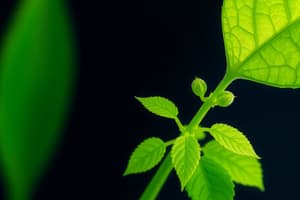Podcast
Questions and Answers
What is the first step in the Calvin cycle?
What is the first step in the Calvin cycle?
- 1,3-bisphosphoglycerate conversion
- Carbon fixation (correct)
- Glyceraldehyde-3-phosphate formation
- RuBP regeneration
Which compound is formed after the carbon fixation step?
Which compound is formed after the carbon fixation step?
- Oxaloacetate
- 3-phosphoglycerate (correct)
- Glyceraldehyde-3-phosphate
- 1,3-bisphosphoglycerate
What role does RuBisCo play in the Calvin cycle?
What role does RuBisCo play in the Calvin cycle?
- It regenerates RuBP
- It synthesizes glucose
- It fixes carbon dioxide (correct)
- It converts NADPH into NADP+
During the reduction phase of the Calvin cycle, how many G3P molecules are produced from 3 CO2?
During the reduction phase of the Calvin cycle, how many G3P molecules are produced from 3 CO2?
What is the main energy input for the Calvin cycle?
What is the main energy input for the Calvin cycle?
Which type of photosynthesis directly fixes CO2 into 3PGA?
Which type of photosynthesis directly fixes CO2 into 3PGA?
In which conditions is C3 photosynthesis least effective?
In which conditions is C3 photosynthesis least effective?
What product is ultimately formed from G3P in the Calvin cycle?
What product is ultimately formed from G3P in the Calvin cycle?
Flashcards
Calvin Cycle
Calvin Cycle
A series of chemical reactions in plants that convert CO2 into glucose using ATP and NADPH.
Carbon Fixation
Carbon Fixation
The process where CO2 is converted into a usable organic form, primarily through the enzyme Rubisco linking CO2 with RuBP.
Reduction Phase
Reduction Phase
Stage in the Calvin Cycle where 3PGA is reduced to G3P, using ATP and NADPH to produce glucose.
Glyceraldehyde-3-phosphate (G3P)
Glyceraldehyde-3-phosphate (G3P)
Signup and view all the flashcards
Regeneration Phase
Regeneration Phase
Signup and view all the flashcards
RuBisCo
RuBisCo
Signup and view all the flashcards
C3 Photosynthesis
C3 Photosynthesis
Signup and view all the flashcards
C4 Photosynthesis
C4 Photosynthesis
Signup and view all the flashcards
Study Notes
Calvin Cycle Overview
- The Calvin cycle is a crucial part of photosynthesis
- It's a process that converts inorganic carbon dioxide into organic molecules, like glucose.
- This process occurs in three phases: carbon fixation, reduction, and regeneration.
Carbon Fixation Phase
- RuBisCo is the key enzyme in this phase
- RuBisCo catalyzes the reaction between CO₂ and RuBP (ribulose 1,5-bisphosphate)
- Forms an unstable six-carbon intermediate that quickly splits into two molecules of 3-PGA (3-phosphoglycerate)
- Marks the point where inorganic carbon is converted to organic form
Reduction Phase
- 3PGA is converted into G3P (glyceraldehyde 3-phosphate)
- This process requires ATP and NADPH, which are provided by the light-dependent reactions.
- This phase effectively reduces 3PGA to G3P, storing energy.
- Out of six G3Ps generated, only one is used to make glucose, the rest are recycled to regenerate RuBP.
Regeneration Phase
- The remaining G3P molecules are used to regenerate RuBP
- This process requires ATP
- This cycle ensures a continuous supply of RuBP to continue fixing CO₂.
Types of Photosynthesis
- The pathways for photosynthesis are C3, C4, and CAM.
- C3 photosynthesis is the most common type, fixing CO₂ directly into 3PGA
- Efficient in cool and moist climates
- Less effective in hot, dry conditions due to photorespiration (in hot conditions RuBisCo mistakenly fixes O₂ rather than CO₂.)
- C4 photosynthesis minimizes photorespiration by concentrating CO₂ in bundle sheath cells.
- This adaptation allows plants to thrive in high temperatures and low water availability.
- CO₂ is initially fixed into oxaloacetate, then converted to malate, ultimately entering the Calvin cycle
- CAM photosynthesis is a modified C4 pathway.
- Plants open their stomata at night to take up CO₂ and store it as organic acids. During the day, CO₂ is released from these acids and used in the Calvin cycle.
- This adaptation helps plants to conserve water in arid environments.
Key Players
- RuBisCo: Fixes inorganic carbon into usable form
- ATP: Provides energy for the Calvin cycle.
- NADPH: Provides electrons to reduce 3PGA to G3P
- Other important molecules: RuBP, 3PGA, G3P, and various intermediate compounds.
Energy Inputs and Outputs
- Energy inputs: ATP and NADPH (from light-dependent reactions)
- Energy output: G3P (glyceraldehyde-3-phosphate), used for glucose synthesis and RuBP regeneration.
Studying That Suits You
Use AI to generate personalized quizzes and flashcards to suit your learning preferences.




